
 |
|
|
After the Great Treck (1835-37) and the Zulu War (1838), the first Boer War (1880-81) marked the first culmination in the strive of the two Boer Republics - the
Zuid-Afrikaansche-Republiek (ZAR) or Transvaal and the Oranje-Vrijstaat (OFS) or Orange Free State - to remain independent from British rule. The Burgher Forces of the Transvaal were victorious in all four battles fought in this
war - the victory in the Battle of Majuba Hill still being celebrated or cursed today, depending on were ones sympathy lies. After this 1st Boer War, the Boer Republics were able to regain their somewhat shortlived independence at
least on paper. But British rule in the Cape Colony and Natal made sure that the discovered riches of gold in the Transvaal were used to destabilise the young republic. In 1895/96, Cecil Rhodes, the former Governor of the Cape
Colony, organised the infamous Jameson Raid on the Transvaal, which was fought off and eventually led to the hardening of lines between the Boer Republic and the British interests in southern Africa. British subjects in the
Transvaal, the socalled Uitlanders, were used for an uprising against the elected Government, and the British High Commissioner for South Africa in Cape Town, Sir Alfred Milner, openly demanded the annexation of the Boer Republic
by the crown. From 2nd to 5th of June 1899, President MT Steyn of the Orange Free State, hosted a Peace Conference between the Transvaal and the British High Commission in Bloemfontein which failed to achieve the desired result.
The number of Imperial British troops in South Africa rose from 8456 men with 24 artillery pieces in december 1898 to 22 104 men with 60 artillery pieces in october 1899. On top of this, Britain called for mobilisation on October
7th 1899, to sent an army corps of 47 551 officers and men with 122 guns to push through the British interests in South Africa. This led to the mobilisation of the ZAR and OFS forces - a total of approx 32 000 civilians under
arms. Further, on October 9th the Transvaal issued an ultimatum to Britain, demanding that all open questions have to be addressed peacefully, all British Imperial troops on the border to the Boer Republic have to be withdrawn and
that all British troops on their way to South Africa have to return to Britain. The ultimatum expired at 5,00 pm on October 10th 1899. On October 11th 1899, about 800 Republicans under General JH Koos de la Rey attacked
the British armoured train “Mosquito” at Kraaipan. Lieutenant Nesbit and thirty-four soldiers, nine of them wounded, surrendered the next morning. The Burgher Troops of the ZAR discovered British Mark IV ammunition in the train,
better known as dumdum.... |
|
|
||||||||||||||||||||
For more detailed information on specific subjects of the Boer War please navigate with these buttons or click on the links at the end of this page. |
|
|
|
||||||||||||||||||||||||||||||||||||||||||||||||||||||||||||||||||||||||||||||||||||||||||||||||||||||||||||||||||||||||||||||||||||||||||||||||||||||||
If all wars, campaigns and punitive expeditions are considered, the Boer War was the 226th of 230 such conflicts involving the British Army during Queen Victorias 64
year reign. In fact, there was not one year of her reign that passed without Britain being involved in any kind of military conflict. The 963 days of fighting in South Africa saw forces from all around the world involved. The
British Empire fought with deployments from Britain as well as Colonial Forces from Australia, Canada, Ceylon (Sri Lanka), India, New Zealand and South Africa. A total of 458.610 Officers and men (including Regulars, Reservists,
Volunteers and Militia). Of that, 22.450 men are considered to be “operational deaths”. The total Imperial Casualties amount to 97.477. |
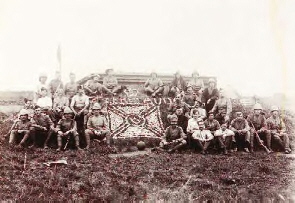 |
||
British troops after the Battle of Elandslaagte |
||
With the exception of 733 men in the Staats Artillery of the ZAR and approx 490 men of the same in the OFS and the Police Forces of the two States, the Boer Forces consisted of civilians put together in Commando Units. All men between the ages of 16-60 were liable to be called up for service. Those between 18-34 came first, then those between 34 and 50 and only in the last resort those ones over 50. Refusal to serve was punished with a fine or three months imprisonment. The strength of the Boer forces at the beginning of the war totalled to 60.291 men under arms. This included a few hundred volunteers from Germany, the Netherlands, Russia and Irland. Total republican war deaths amounted to 6.189, with a total of casualties of approx 35.000. (For more detailed figures go to the “Stats´n Facts” Page) |
|
|
The Butcher´s Bill was paid by Boer women and children. In his attempt to weaken the Boer forces by destroying their hinterland, the British Commander in Chief, Field
Marshal Earl Roberts of Kandahar, followed a “Scorched Earth Policy”. All farms in the way of his troops were burnt down and as of June 1901 the wifes and children of Boer fighters were put into Concentration Camps. It was here
were Britain eventually won the war. In just 11 months (until the end of the war in may 1902) a total of 27.927 people died in British Concentration Camps, 22.074 of them children under 16. |
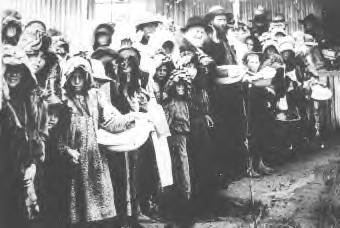 |
|||||
Foodline at the Krugersdorp Concentration Camp |
|||||
Discipline, or the lack thereof, was a major problem within the Boer forces. As all Burghers in arms were more or less fighting because of their own free will and first
and foremost civilians, a great number of them headed home for vacation and rest, or quit the service for good, once they felt like it. Some commandos lost up to half of their strength after a battle because soldiers went home,
only to come back to the front when they pleased. All commanding officers were elected by the people and could be stripped off their ranks if the Government and/or the Burghers felt a need to do so. It was not by military orders
that the Boer forces were successfully led in combat but through true leadership. Men like Louis Botha, Christiaan de Wet, Jan Smuts, Koos de la Rey and Danie Theron led their men by example and through hard earned respect. The
personal values of the individual were the key element in keeping the Boer forces together. |
On the British side, the Empire sent out its finest soldiers. Men of great honour and courage. Men that fought in the Sudan and Egypt, in India and
Afghanistan. Veterans of the Crimea and the Zulu Wars. Earl Roberts of Kandahar, Honourable Viscount Kitchener of Khartoum, Sir Redvers Buller and the Earl of Dundonald to name but a few. Hard drilled regiments with many a bearer
of the Victoria Cross were sent to fight the farmers of South Africa. It was the turn of the century - and the dawning of a new age in modern warfare. Were some British officers did learn from the military actions in India and
the American Civil War, others, mainly the ones having fought against the Mahdi uprising, were still too focused on old tactics. Attacking trenches in infantry columns was the costliest mistake the British made during the war.
Strangely enough it took them some time to find that out for themselfes. |
||||||||||
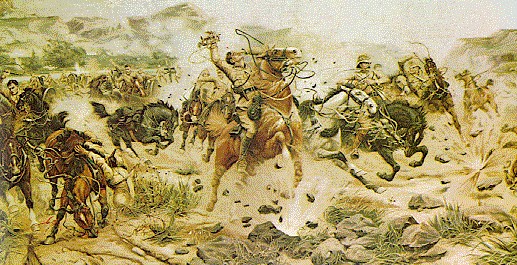 |
||||||||||
The Guns at Colenso |
||||||||||
The war was devided into two stages: the conventional war with setpiece battles and sieges (1899 to early 1900) and the guerrilla war (early 1900 until 31.
May 1902). The Boer plan was to invade Natal from the west, north and east to subdue the garrisons of Dundee (Talana) and Ladysmith. In the west, the British towns of Mafeking, Vryburg and Kimberley along the railwayline to
Bechuanaland (Botswana) were to be attacked and captured. It was also anticipated that the Boers in the Cape Colony would engage in a major uprising against British rule. With Natal and most of the Cape Colony in hand, the Boer
Republics would try to hold out against the British invasion forces until sympathetic European powers would back up their call for freedom. At the outbreak of hostilities not all British troops that were called up for service had
arrived in South Africa. Hence, many colonial units from the Cape and Natal colonies were engaged in the early battles. Strong resistance by British and Colonial troops led to the unsuccessful sieges of Kimberley (14 October 1899
- 15 February 1900), Mafeking (14 October 1899 - 17 May 1900) and Ladysmith (2 November 1899 - 28 February 1900), and subsequently to the Boers failing to reach their strategic objectives. |
||||||||||
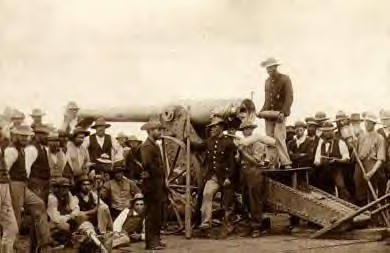 |
||||||||||
155 mm Creusot (Long Tom) at the Siege of Ladysmith |
||||||||||
The Transvaal brought 4 of those guns into the war. All of them had to be destroyed by the Boers to prevent them from being captured by the British. |
||||||||||
Although, on paper, the Boer commandos were no match for the forces of the British Empire, their excellent marksmenship, the long range of the German Mauser rifles,
their smokeless ammunition and the typical strong will of the Boers were the key-elements for the tremendous success of their military actions. When, in early 1900 Lord Kitchener left South Africa for England, believing that the
war was won and almost over, his successor as Commander in Chief, Viscount Kitchener of Khartoum, took over where Roberts left off at his “Scorched Earth Policy” - taking it to a max. All Boer farms were destroyed, all crops were
burnt and all livestock was killed. Thus robbing the Boer fighters of their logistical infrastructure. But through all the misery and war crimes the English commited the fight for freedom was far from over for the Boer fighters.
The guerilla war created the toughest fighter of them all - The Bittereinder. |
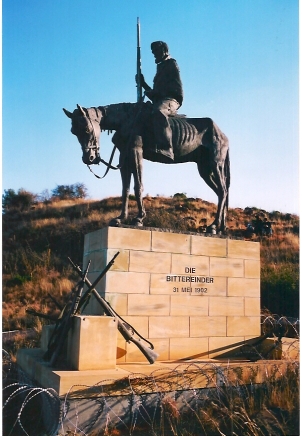 |
||
Die Bittereinder approx 20.000 Boer fighters in arms
were still in the field when the treaty was signed on 31st May 1902. Statue at the Boer War Museum / Mother and Children Memorial in Bloemfontein |
||
See the action, the figures and the drama on the following pages: |
|
|
|
||||||||||||||||||||||||||||||||||||||||||||||||||||||||||||||||||||||||||||||||||||||||||